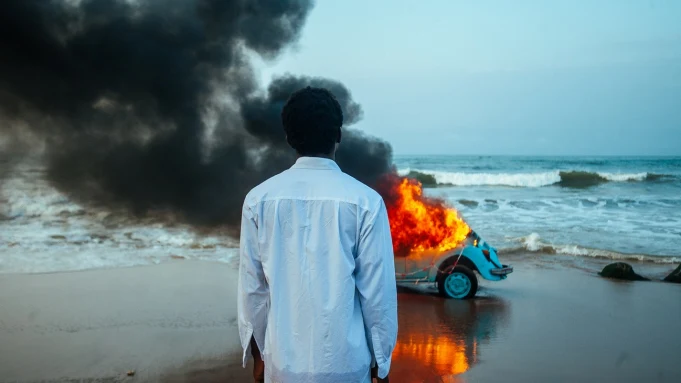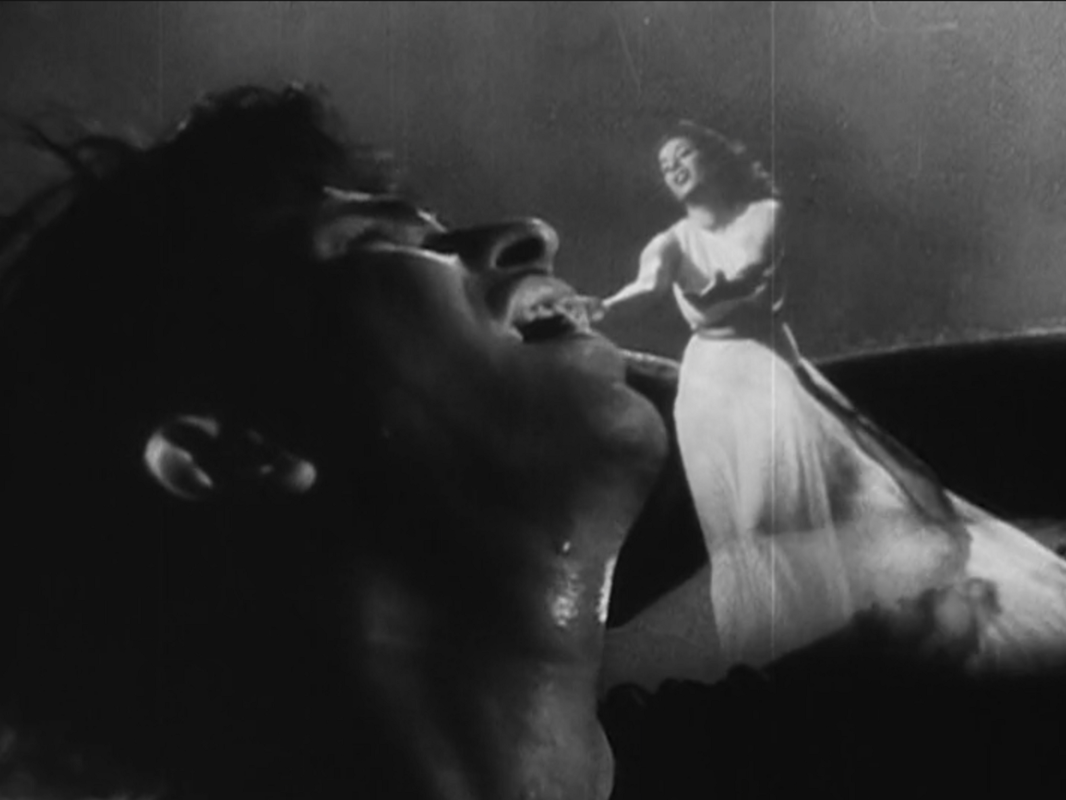
The Red Phallus is a brutal film. It treats its characters in a blunt matter of fact manner, where there is little room for rationalizations, hope, or redemption. It feels a little like a Flannery O’Connor story where suffering is not so much explored as simply placed in your lap like something heavy and immovable.
The story centers around a very troubled 16-year-old girl named Sangay. What is troubling her is not revealed until late in the film. She’s lives with her father in rural Bhutan amidst the expansive planes and towering mountains. The film has a wide aspect ratio allowing Tashi Gyeltshen, the director, to present his characters as tiny figures, vulnerable and lost in an enormous and deep focus panorama. The Red Phallus might qualify as a “slow film” in that the landscape shots are very long and often involve watching a single figure make its way across a long expanse.

Sangay is sullen and defiant. She hardly ever speaks but when she does she expresses only anger and contempt for everything and everyone. There are references to some kind of mental health episode or crisis in her past. Hallucinations are mentioned, but nothing is ever nailed down or explained. As much as there are hints at mental illness there are also hints that we may be watching a subjective film, where what we see are different people’s perceptions, not a shared reality.
To understand The Red Phallus you need to understand Buddhist ideas about Karma. The kind of Buddhism practiced in Bhutan is often referred to as Theravada Buddhism. It is the earliest form of Buddhism and is closest to what was originally practiced in the Indus Vally a few hundred years BCE. The Theravada understanding of Karma is far more complex and nuanced than the modern-day “what comes around goes around” interpretation.
In Theravada Buddhism Karma refers to a cosmic wheel whose spinning is fueled by our actions, all our actions, positive or negative. In Theravada Buddhism, all karma is a problem regardless of whether it is good or bad. Karma means action. All actions bind you closer to the world in which you live and therefore bind you closer to suffering. Our actions create an illusion that we can control our world, and inevitably lead to our suffering when we realize that we can not control anything. We become trapped by our desire to fix and arrange our lives when what we should be doing is practicing acceptance. This is not a doctrine of helplessness but it is a doctrine of inaction. Nothing needs to be fixed, human beings are perfect just as they are. If you are suffering it because you are doing too much, trying too hard, and caught up in an illusion that distracts you from your true “buddha nature (perfect peace and equanimity). The image below is from Tibetan Buddhism which came after Theravada Buddhism, but it illustrates the cycle of karma and how it functions.

Sangay is the furthest thing from equanimity or acceptance. She is stubbornly stuck resisting any offers of help or concern. In the film the issues raised concerning karma mostly revolve around Sangay’s being involved with a butcher. The nature of their relationship is unclear but he is a married man with a family and it is implied that he and Sangay are more than just friends. Everyone around them believes they are sleeping together, but it’s unclear if they actually are.
Butchers in some parts of Asia are seen as karmically cursed. Their job necessarily entails a constant accruing of bad Karma. Eating the meat they sell is not seen as bad karma, it is only the slaughterer who pays the price. Historically many Asian countries have forced butchers to live on the outskirts of town where they were treated as pariahs.
Sangay comes from a humble but still “better” family and is told by her father to stay away from the butcher. Sangay’s father has a somewhat elevated or spiritual job. He plays the role of an atsara at festivals. Atsara’s are mythical trickster figures who use clowning and humor to expose people who are trying to keep up haughty appearances. Atsaras use big wooden phalluses to both make people laugh as well as to poke and provoke them into exposing their true nature.
Sangay’s father’s karma is “cleaner” than the butcher’s and her father appeals to the butcher to leave Sangay alone lest he spoil her karmic status. Karma has its spiritual meaning but its roots are political. When the Aryans invaded what is now Northern India they brought with them the cast system. People were sorted into hierarchical strata that could never be changed. Social mobility was impossible. This meant that the life you were born into was your fate. To temper what could be seen as a cruel and harsh system, reincarnation was used as a deferred promise of happiness. If you were well behaved in this life, good karma would assure you an auspicious position in your next life. Reincarnation also justified poverty as a punishment for a past life, and just for good measure if you were really bad you might be reincarnated as a woman. In practice, reincarnation was a cruel catch-all for justifying inequality, inequality, and the status quo.
Even with the hope of a better reincarnation, life for The Theravada Buddhist is “samsara.” This means that life is a trap, where the ordinary functioning of daily business keeps us from transcendence. As long as you are flesh and blood life you will experience “dhuka,” a Sanskrit word sometimes translated as suffering, and sometimes as unsatisfying.

For Sangay, everything seems like a trap. If she sleeps with the butcher she will be bound to him. If she listens to her father she will be expected to follow in his footsteps and make red phalluses for the rest of her life. School seems like a pointless set of arbitrary rules that leads nowhere. Everything and everyone antagonizes her.
As is implied by the red phalluses, penises are a running theme throughout the film. Sangay is embarrassed by her father’s profession. As part of his role as Atsara he makes hundreds of red wooden penises and hands them out for good luck. Penises have been a means to ward off the evil eye in many cultures for many centuries. In Pompeii, there is a penis carved into the doorstep of every house. We watch Sangay’s father sand one phallus in a tense, close up and uncomfortable scene. It looks like masturbation but it is rough and menacing.
It slowly surfaces that there is more to Sangay’s dislike of the phalluses than just embarrassment. It implied that she may have been raped when she was younger. Throughout the film, we are never completely sure if what we are watching is reality, a memory, a hallucination, or a subjective impression. At one point Sangay is walking home and a group of atsara’s begin following her. It is clear that we are not seeing reality, but it is unclear what it is we are seeing. They assemble in a crowd behind her, smacking wooden phalluses in their hands like clubs. They emerge through the haze and follow her through a field, red figures against the green vegetation. It could be a dream, her imagination, a hallucination, or just cinematic symbolism.

Spoilers ahead
Penises become increasingly more threatening as the film progresses until the butcher finally rapes Sangay in a field. The next day she asks to meet him again. They argue, as they always do, and then Sangay beats him to death with an unidentified object. Their arguments are always comprised of pointless recriminations that neither of them hears or understands. Whatever affection or attraction they might have had for each other was drowned in a relentless sea of anger, mistrust, and fear. Actually, this description applies to all of the dialogue in the film. There isn’t much dialogue, to begin with, but when characters do speak they are only venting and are generally unheard.
The pointless dialogue only intensifies the pain of the characters. They wriggle in a web of circumstances that are indifferent to their frustrations and explanations. There is nothing in the film or in the world of these characters to provide hope or stability.
After killing the butcher, Sangay goes home and smashes all of her father’s phalluses and then stabs herself to death with one of them off-screen. The scene ends with an unfinished wooden phallus turning red as it lies on the floor slowly soaking up a growing pool of Sangay’s exsanguination.
Her death feels more like relief than tragedy. All we ever saw from her was anger and depression. Suicide was her escape. It was not a spiritual attempt at liberation, it was a desperate act of anger, but still, for a moment she was released from samsara.
In addition to the phallus, the apsara mask also features prominently as a theme. Atsaras unmasks those who would put on airs, and the butcher continually tries to expose both Sangay and her father as being holier than thou. Sangay herself wears a mask of aggression and defiance to keep everyone and everything at bay.

The characters in The Red Phallus are confused as to what is driving their fate. The laws of Karma and morality seem to be pushing them in one direction but Sangay, her father, and the butcher find themselves in opposition to what seems fated. They are all dissatisfied with their lives but unsure of how to proceed.
Tashi Gyeltshen wrote and directed The Red Phallus in 2018. He layered the narrative so that the forces that push his characters forward are hard to sort through. It’s not hard to see the forces themselves but it is difficult to identify which one is truly driving each individual. Sangay is clearly traumatized and motivated by a short-sighted need for relief, but the source of trauma is a tangle of her current circumstances, events from her past, and her belief system. Her actions are motivated by the narrative she is constructing about her life and whether she sees a way to change it. Like in Macbeth there are competing elements that drive the tragedy forward.
The audience must wrestle along with the characters to suss out when and where things went awry. Gyeltshen presents us with a simple and painful drama. It is in our trying to understand why these events happened that the complexity unfolds. Like in many great films we the audience have to participate in the construction of the film in order to complete it.

If you enjoyed this article click here for more
www.filmofileshideout.com/archives/the-personal-and-the-symbolic-in-oscar-catacoras-powerful-film-eternity



